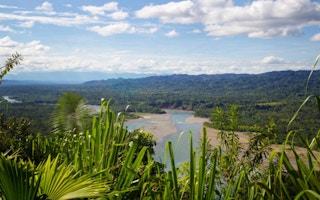By now you’ve probably heard of COP26 - the shorthand name for the next major UN climate summit, rescheduled for November in Glasgow after being delayed a year by the coronavirus pandemic.
But another big “Convention of the Parties” (COP) is taking place a month earlier - one that is far less talked about but also critically important. That is COP15: the UN biodiversity summit planned for China in October.
Efforts to protect the natural world have yet to achieve the same high profile as those to limit climate change, despite advocacy by naturalist David Attenborough and many others.
Losses of crucial ecosystems like rainforests and wetlands, as well as animal species, have accelerated even as governments, businesses, financiers and conservation groups seek effective ways to protect and restore more of the Earth’s land and seas.
So what is COP15, and what does it hope to achieve?
What is the ‘Convention on Biological Diversity’?
Originally signed at the Rio Earth Summit in 1992 and later ratified by about 195 countries not including the United States, it is designed to protect diversity of plant and animal species and ensure natural resources are used sustainably.
It also aims to achieve “fair and equitable sharing” of benefits from natural genetic material, used in everything from medicines to new crop species.
In practice that means making sure indigenous communities and countries home to biological riches benefit from their use.
Why is protecting nature better so important?
Around the world, forests and other natural ecosystems are being rapidly destroyed, often to expand agriculture and production of commodities like palm oil, soy and beef as the world’s population grows.
But people depend on nature, from oceans to wildernesses, to supply clean air and water, and to regulate rainfall that is vital for food supplies. If too many ecosystems vanish, their basic life support services can falter, scientists warn.
Because plants absorb planet-heating carbon dioxide to grow, better protecting or expanding natural areas is also one of the cheapest and most effective ways to slow climate change.
What does COP15 aim to do?
At the UN summit from Oct. 11-24 in Kunming, China, countries plan to agree a new global treaty to halt and reverse losses of the planet’s plants, animals and ecosystems.
The meeting hopes to set both long-term goals for mid-century and shorter-term targets for 2030 and, crucially, push for those to be enshrined in national policies.
That mostly did not happen with previous global targets to slash biodiversity loss, set in 2002 and 2010, which were largely not met.
“Nobody actually owned those targets. No wonder in 10 years’ time we discover none of those targets are fully fulfilled,” said Li Shuo, a senior climate and energy policy officer for Greenpeace China.
Who’s leading the push?
Countries pushing for greater ambition on nature protection include Canada, the European Union, Costa Rica, Colombia and Britain, according to Georgina Chandler, an international policy expert with the UK-based Royal Society for the Protection of Birds (RSPB).
But most of those champions are focused on particular aspects of the agreement rather than the overall deal, she said.
Brazil and Argentina, meanwhile, are seen as the “laggards”, said Li of Greenpeace, with both concerned tougher rules could affect their agricultural expansion and economies.
The United States never ratified the original biodiversity treaty and so is not part of the negotiations.
But President Joe Biden has committed to protect at least 30 per cent of his country’s land and coastal waters by 2030, as part of a broader international “30x30” campaign.
What is China’s role as COP15 host?
In a bid to make a success of the COP26 UN climate talks in Scotland in November, British officials have launched a big diplomatic push to clear potential roadblocks and win new commitments to climate action before the meeting begins.
That “diplomatic outreach and engagement” is a normal part of the job for each host country, said Chandler of the RSPB.
But that’s generally not the case for the Convention on Biological Diversity meetings, she added - and “it’s not the way China does things - to reach out to facilitate agreement in that way”.
“It’s a different hosting style,” she said.
Despite a series of online negotiating sessions this year before the main conference, more big issues could be left to be settled in October, experts said.
China has managed some diplomatic wins, however, including tamping down resistance by some countries to holding virtual negotiations as the coronavirus pandemic continues, they said.
What needs to come out of COP15?
Not only broad targets to improve nature protection are required, but also commitments of finance to help poorer countries achieve them, and clear ways of comparing and measuring the efforts by different countries, analysts said.
Until now, the Convention on Biological Diversity “can be understood as the Paris Agreement with the 1.5 degree target but no rule-book, no finance,” said Li of Greenpeace China.
Any new targets set at COP15 need to be “smart and measurable” rather than “fluffy and ever-extending”, with standardisation across countries so they can be compared, the RSPB’s Chandler said.
A specific figure for new nature finance is unlikely to emerge from COP15, but there could be a vaguer commitment to double it or something similar, she added.
Targets might also be set to eliminate harmful agricultural, fishing and logging subsidies, and repurpose that money to benefit nature, an additional way of raising needed cash.
What will COP15 tell us about COP26?
With the COP15 biodiversity negotiations happening just a month before the UN climate talks, how China handles holding major in-person negotiations during a pandemic will have big implications for COP26 and its organisers.
In particular, how the COP15 summit manages vaccination requirements, quarantine measures and efforts to include a broad range of civil society participants beyond government delegations will be key.
There has also been a push for closer links between the two largely separate nature and climate political agendas, with scientists explaining how efforts to tackle climate change and biodiversity loss must be approached jointly for the best results.
This story was published with permission from Thomson Reuters Foundation, the charitable arm of Thomson Reuters, that covers humanitarian news, climate change, resilience, women’s rights, trafficking and property rights. Visit http://news.trust.org/climate.












